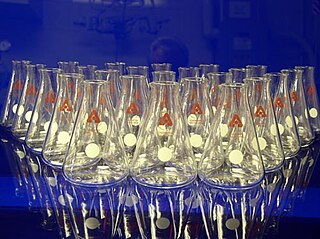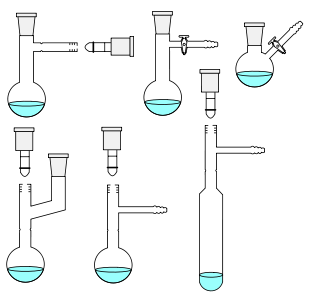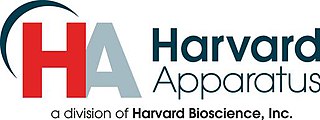Related Research Articles

Laboratory glassware refers to a variety of equipment used in scientific work, and traditionally made of glass. Glass can be blown, bent, cut, molded, and formed into many sizes and shapes, and is therefore common in chemistry, biology, and analytical laboratories. Many laboratories have training programs to demonstrate how glassware is used and to alert first–time users to the safety hazards involved with using glassware.

A laboratory is a facility that provides controlled conditions in which scientific or technological research, experiments, and measurement may be performed. Laboratories are found in a variety of settings such as schools, universities, privately owned research institutions, corporate research and testing facilities, government regulatory and forensic investigation centers, physicians' offices, clinics, hospitals, regional and national referral centers, and even occasionally personal residences.

Pyrex is a brand introduced by Corning Inc. in 1915 for a line of clear, low-thermal-expansion borosilicate glass used for laboratory glassware and kitchenware. It was later expanded to include kitchenware products made of soda-lime glass and other materials.

Quickfit is a brand of laboratory glassware, produced under the Pyrex trademark and distributed through various fronts in differing countries; e.g. Corning in North America. The glassware is well known worldwide for its build quality and it appears in numerous laboratories. A large percentage of the glassware makes use of ground glass joints.

The Merck Group, branded and commonly known as Merck, is a German multinational science and technology company headquartered in Darmstadt, with about 60,000 employees and present in 66 countries. The group includes around 250 companies; the main company is Merck KGaA in Germany. The company is divided into three business lines: Healthcare, Life Sciences and Electronics. Merck was founded in 1668 and is the world's oldest operating chemical and pharmaceutical company, as well as one of the largest pharmaceutical companies in the world.

Wheaton Industries was a long-standing famous manufacturer of glassware and ceramics products in Millville, New Jersey, USA. A spin-off of the original firm adopted the name in 2006.
Wheaton Science Products is a subsidiary of Alcan based in Millville, New Jersey in the United States. The company manufactures glassware products for scientific and laboratory applications.

Borosilicate glass is a type of glass with silica and boron trioxide as the main glass-forming constituents. Borosilicate glasses are known for having very low coefficients of thermal expansion, making them more resistant to thermal shock than any other common glass. Such glass is subjected to less thermal stress and can withstand temperature differentials without fracturing of about 165 °C (300 °F). It is commonly used for the construction of reagent bottles and flasks as well as lighting, electronics, and cookware.

Laboratory flasks are vessels or containers that fall into the category of laboratory equipment known as glassware. In laboratory and other scientific settings, they are usually referred to simply as flasks. Flasks come in a number of shapes and a wide range of sizes, but a common distinguishing aspect in their shapes is a wider vessel "body" and one narrower tubular sections at the top called necks which have an opening at the top. Laboratory flask sizes are specified by the volume they can hold, typically in metric units such as milliliters or liters. Laboratory flasks have traditionally been made of glass, but can also be made of plastic.

Schott AG is a German multinational glass company specializing in the manufacture of glass and glass-ceramics. Headquartered in Mainz, Germany, it is owned by the Carl Zeiss Foundation. The company's founder and namesake, Otto Schott, is credited with the invention of borosilicate glass.

Friedrich Otto Schott (1851–1935) was a German chemist, glass technologist, and the inventor of borosilicate glass. Schott systematically investigated the relationship between the chemical composition of the glass and its properties. In this way, he solved fundamental problems in glass properties, identifying compositions with optical properties that approach the theoretical limit. Schott's findings were a major advance in the optics for microscopy and optical astronomy. His work has been described as "a watershed in the history of glass composition".

Trolli is a German manufacturer of confectionery. Its American arm was sold in 1996 and became a confectionery brand used by Ferrara Candy Company. Trolli sells gummy candies, marshmallows, and soft licorice gums in over 80 countries and has factories in Germany, Spain, Indonesia, USA, China and the Czech Republic.

A Schlenk flask, or Schlenk tube, is a reaction vessel typically used in air-sensitive chemistry, invented by Wilhelm Schlenk. It has a side arm fitted with a PTFE or ground glass stopcock, which allows the vessel to be evacuated or filled with gases. These flasks are often connected to Schlenk lines, which allow both operations to be done easily.

Chance Brothers and Company was a glassworks originally based in Spon Lane, Smethwick, West Midlands, in England. It was a leading glass manufacturer and a pioneer of British glassmaking technology.

Harvard Apparatus is a major US manufacturer of specialized physiological research laboratory equipment with current headquarters in Holliston, Massachusetts.

The Sneath Glass Company was an American manufacturer of glass and glassware. After a brief 1890s startup in Tiffin, Ohio, the Company moved to Hartford City, Indiana, to take advantage of the Indiana Gas Boom. The small city was enjoying the benefits of the boom, and could provide natural gas as an energy source for manufacturers. Sneath Glass was one of many glass manufacturers that moved to the region, and became Hartford City's second largest employer.
Alfa Aesar, headquartered in Ward Hill, Massachusetts, United States, is a supplier of reagents and materials for use in research and development, and analysis. They have facilities in many countries and manufacture many of the chemicals they sell.
Gerresheimer AG is a German manufacturer of primary packaging products for medication and drug delivery devices made of special-purpose glass and plastics with headquarters in Düsseldorf for the pharmaceutical and cosmetics industries. The company has production operations in Europe, the Americas and Asia.
Louis Firth Nafis was an American entrepreneur and inventor, best known as the first manufacturer of the standard Babcock milk test bottle. He was born in Jersey City, New Jersey on November 1, 1884, and died on February 26, 1955, in Evanston, Illinois.
References
- ↑ "Gerresheimer Successfully Finalises Formation of Joint Venture "Kimble Chase Life Science and Research Products LLC"" (Press release). PRNewswire. 2007-07-03. Retrieved 2010-07-30.